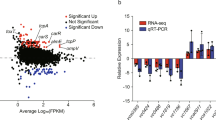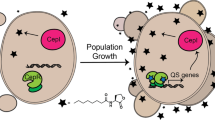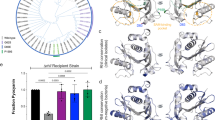Abstract
Vibrio cholerae, the bacterium that causes the disease cholera, controls virulence factor production and biofilm development in response to two extracellular quorum-sensing molecules, called autoinducers. The strongest autoinducer, called CAI-1 (for cholera autoinducer-1), was previously identified as (S)-3-hydroxytridecan-4-one. Biosynthesis of CAI-1 requires the enzyme CqsA. Here, we determine the CqsA reaction mechanism, identify the CqsA substrates as (S)-2-aminobutyrate and decanoyl coenzyme A, and demonstrate that the product of the reaction is 3-aminotridecan-4-one, dubbed amino-CAI-1. CqsA produces amino-CAI-1 by a pyridoxal phosphate–dependent acyl-CoA transferase reaction. Amino-CAI-1 is converted to CAI-1 in a subsequent step via a CqsA-independent mechanism. Consistent with this, we find cells release ≥100 times more CAI-1 than amino-CAI-1. Nonetheless, V. cholerae responds to amino-CAI-1 as well as CAI-1, whereas other CAI-1 variants do not elicit a quorum-sensing response. Thus, both CAI-1 and amino-CAI-1 have potential as lead molecules in the development of an anticholera treatment.
This is a preview of subscription content, access via your institution
Access options
Subscribe to this journal
Receive 12 print issues and online access
$259.00 per year
only $21.58 per issue
Buy this article
- Purchase on Springer Link
- Instant access to full article PDF
Prices may be subject to local taxes which are calculated during checkout


Similar content being viewed by others
References
Greenberg, E.P. Bacterial communication and group behavior. J. Clin. Invest. 112, 1288–1290 (2003).
Parsek, M.R. & Greenberg, E.P. Sociomicrobiology: the connections between quorum sensing and biofilms. Trends Microbiol. 13, 27–33 (2005).
Waters, C.M. & Bassler, B.L. Quorum sensing: cell-to-cell communication in bacteria. Annu. Rev. Cell Dev. Biol. 21, 319–346 (2005).
Hammer, B.K. & Bassler, B.L. Quorum sensing controls biofilm formation in Vibrio cholerae. Mol. Microbiol. 50, 101–104 (2003).
Jobling, M.G. & Holmes, R.K. Characterization of hapR, a positive regulator of the Vibrio cholerae HA/protease gene hap, and its identification as a functional homologue of the Vibrio harveyi luxR gene. Mol. Microbiol. 26, 1023–1034 (1997).
Miller, M.B., Skorupski, K., Lenz, D., Taylor, R.K. & Bassler, B.L. Parallel quorum sensing systems converge to regulate virulence in Vibrio cholerae. Cell 9, 303–314 (2002).
Zhu, J. & Mekalanos, J.J. Quorum sensing-dependent biofilms enhance colonization in Vibrio cholerae. Dev. Cell 5, 647–656 (2003).
Zhu, J. et al. Quorum-sensing regulators control virulence gene expression in Vibrio cholerae. Proc. Natl. Acad. Sci. USA 99, 3129–3134 (2002).
Higgins, D.A. et al. The major Vibrio cholerae autoinducer and its role in virulence factor production. Nature 450, 883–886 (2007).
Chen, X. et al. Structural identification of a bacterial quorum-sensing signal containing boron. Nature 415, 545–549 (2002).
Schauder, S., Shokat, K., Surette, M.G. & Bassler, B.L. The LuxS family of bacterial autoinducers: biosynthesis of a novel quorum sensing signal molecule. Mol. Microbiol. 41, 463–476 (2001).
Gopishetty, B. et al. Probing the catalytic mechanism of S-ribosylhomocysteinase (LuxS) with catalytic intermediates and substrate analogues. J. Am. Chem. Soc. 131, 1243–1250 (2009).
Miller, S.T. et al. Salmonella typhimurium recognizes a chemically distinct form of the bacterial quorum-sensing signal AI-2. Mol. Cell 15, 677–687 (2004).
Pei, D. & Zhu, J. Mechanism of action of S-ribosylhomocysteinase (LuxS). Curr. Opin. Chem. Biol. 8, 492–497 (2004).
Eliot, A.C. & Kirsch, J.F. Pyridoxal phosphate enzymes: mechanistic, structural, and evolutionary considerations. Annu. Rev. Biochem. 73, 383–415 (2004).
Alexeev, D. et al. The crystal structure of 8-amino-7-oxononanoate synthase: a bacterial PLP-dependent, acyl-CoA-condensing enzyme. J. Mol. Biol. 284, 401–419 (1998).
Izumi, Y., Morita, H., Tani, Y. & Ogata, K. Partial purification and some properties of 7-keto-8-aminopelargonic acid synthetase, an enzyme involved in biotin biosynthesis. Agric. Biol. Chem. 37, 1327–1333 (1973).
Webster, S.P. et al. Mechanism of 8-amino-7-oxononanoate synthase: spectroscopic, kinetic, and crystallographic studies. Biochemistry 39, 516–528 (2000).
Jahan, N. et al. Insights into the biosynthesis of the Vibrio cholerae major autoinducer CAI-1 from the crystal structure of the PLP-dependent enzyme CqsA. J. Mol. Biol. 392, 763–773 (2009).
Otwinowski, Z. & Minor, W. Processing of x-ray diffraction data collected in oscillation mode. Methods Enzymol. 276, 307–326 (1997).
Storoni, L.C., McCoy, A.J. & Read, R.J. Likelihood-enhanced fast rotation functions. Acta Crystallogr. D Biol. Crystallogr. 60, 432–438 (2004).
Perrakis, A., Morris, R. & Lamzin, V.S. Automated protein model building combined with iterative structure refinement. Nat. Struct. Biol. 6, 458–463 (1999).
Emsley, P. & Cowtan, K. Coot: model-building tools for molecular graphics. Acta Crystallogr. D Biol. Crystallogr. 60, 2126–2132 (2004).
Murshudov, G.N., Vagin, A.A. & Dodson, E.J. Refinement of macromolecular structures by the maximum-likelihood method. Acta Crystallogr. D Biol. Crystallogr. 53, 240–255 (1997).
Davis, I.W. et al. MolProbity: all-atom contacts and structure validation for proteins and nucleic acids. Nucleic Acids Res. 35, W375–W383 (2007).
Kleywegt, G.J. & Jones, T.A. Detection, delineation, measurement and display of cavities in macromolecular structures. Acta Crystallogr. D Biol. Crystallogr. 50, 178–185 (1994).
Acknowledgements
We thank the staff of the National Synchrotron Light Source beamline X29 for assistance with X-ray data collection; N. Ruiz and A. Arnaudo (Princeton University) for strains; and J. Kirsch for insightful discussions. This work was supported by the Howard Hughes Medical Institute; US National Institutes of Health grants AI054442, GM065859 and AI069326; US National Science Foundation grant MCB-0639855; and a Dr. Horst Witzel Fellowship from Cephalon Corporation (to M.E.B.).
Author information
Authors and Affiliations
Contributions
R.C.K., structural and spectroscopic analyses; M.E.B., chemistry; D.A.H. and W.-L.N., biology; W.L., mass spectrometry; P.D.J., crystallography. J.D.R., M.F.S., F.M.H. and B.L.B. provided guidance.
Corresponding author
Supplementary information
Supplementary Text and Figures
Supplementary Figures 1–6, Supplementary Tables 1–5 and Supplementary Methods (PDF 1895 kb)
Rights and permissions
About this article
Cite this article
Kelly, R., Bolitho, M., Higgins, D. et al. The Vibrio cholerae quorum-sensing autoinducer CAI-1: analysis of the biosynthetic enzyme CqsA. Nat Chem Biol 5, 891–895 (2009). https://doi.org/10.1038/nchembio.237
Received:
Accepted:
Published:
Issue Date:
DOI: https://doi.org/10.1038/nchembio.237
This article is cited by
-
Design of novel anti-quorum sensing peptides targeting LuxO to combat Vibrio cholerae pathogenesis
In Silico Pharmacology (2023)
-
Exploring AI-2-mediated interspecies communications within rumen microbial communities
Microbiome (2022)
-
The role of bacterial signaling networks in antibiotics response and resistance regulation
Marine Life Science & Technology (2022)
-
Molecular Relationships in Biofilm Formation and the Biosynthesis of Exoproducts in Pseudoalteromonas spp.
Marine Biotechnology (2022)
-
Cross-kingdom inhibition of bacterial virulence and communication by probiotic yeast metabolites
Microbiome (2021)



